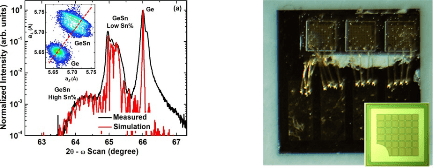Fourier-transform Infrared Spectroscopy for the Measurement of GeSn/(Si)GeSn
Student: Solomon Ojo
Degree: M.S., May 2020
Major Professor: Dr. Fisher Yu
Research Area(s):
Microelectronics
Photonics
Background/Relevance
-
High-performance silicon-based lasers and detectors are sought after, owing to the possibility of monolithic integration of photonics with high-speed Si electronics.
-
GeSn/SiGeSn offer design options from bulk to heterostructure and quantum wells useful for the fabrication of a group IV laser.
Innovation
-
Bandgap engineering for efficient light emission with wide range of wavelength coverage from near to Long-wave infrared.
-
Explore novel growth techniques to reduce defects and gain access to compositions never grown before; high quality and stable (Si)GeSn alloys with high Sn content.
Approach
- Epitaxial growth of high Sn composition of GeSn and SiGeSn using PEUHV-CVD.
- LED and laser devices fabrication.
- Investigate (Si)GeSn electrical and optical properties using Fourier-transform infrared spectroscopy (FTIR).
- Investigate structural parameters by transmission electron microscopy (TEM) and high resolution X-ray diffraction (HRXRD).
- Temperature-dependent PL spectroscopy in a cooled closed-cycle cryostat.

Key Results
- Improved optically pumped GeSn lasers with high operating temperature towards RT.
- Higher Sn incorporation with optimization of parameters for Plasma Enhancement technique
- Enhanced radiative recombination due to the localization of electrons and holes in laser diode structures.

Conclusions
-
Electroluminescence lasing temperature up to 110 K, with 11 % Sn incorporation (World record).
-
Improved carrier confinement by increasing SiGeSn cap thickness, reducing optical loss from the metal contact, and reduced threshold.
- Development of a systematic method to explore the optimal growth condition to achieve higher quality and higher Sn composition.
Future Work
-
MQW development for future devices such as lasers, LED, and photodetector should be further investigated.
